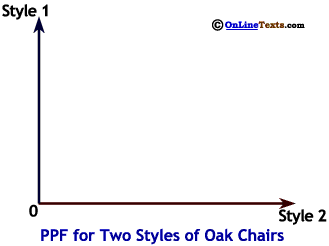


 The PPFs we have considered so far had a "bowed out" shape because resources were specialized. Put another way, the resources available were such that they were more suited to one type of production than another. This is not always the case. Consider a very simple example of a small furniture firm that makes two styles of oak chairs, cleverly referred to as Style 1 and Style 2. Suppose these two styles of chairs, while different, require exactly the same about of oak, labor, glue, fabric, etc. The firm can produce 12 chairs a day regardless of the particular mix of styles it chooses to produce.
The PPFs we have considered so far had a "bowed out" shape because resources were specialized. Put another way, the resources available were such that they were more suited to one type of production than another. This is not always the case. Consider a very simple example of a small furniture firm that makes two styles of oak chairs, cleverly referred to as Style 1 and Style 2. Suppose these two styles of chairs, while different, require exactly the same about of oak, labor, glue, fabric, etc. The firm can produce 12 chairs a day regardless of the particular mix of styles it chooses to produce.
To the right, we show three possible production choices facing this small firm. It could choose to produce at point A, turning out 9 Style 1 chairs and 3 Style 2 chairs. Or, it could choose B where it produces 6 chairs of each style, or C where it makes 3 Style 1 chairs and 9 Style 2 chairs. It can choose any combination of 12 chairs, including producing 12 a day of only one style.22 This firm's PPF for oak chairs is a straight line with a slope of -1. The PPF is linear because the opportunity cost of Style 1 chairs in terms of Style 2 chairs is constant.


22 The unbroken line we use for the PPF suggests that the firm can make chairs in fractional quantities. This is actually quite reasonable. In a 10 day period the firm can choose to produce 95 Style 1 chairs and 25 Style 2 chairs, or 9.5 and 2.5 per day, so every point on the PPF is feasible.


 The PPFs we have considered so far had a "bowed out" shape because resources were specialized. Put another way, the resources available were such that they were more suited to one type of production than another. This is not always the case. Consider a very simple example of a small furniture firm that makes two styles of oak chairs, cleverly referred to as Style 1 and Style 2. Suppose these two styles of chairs, while different, require exactly the same about of oak, labor, glue, fabric, etc. The firm can produce 12 chairs a day regardless of the particular mix of styles it chooses to produce.
The PPFs we have considered so far had a "bowed out" shape because resources were specialized. Put another way, the resources available were such that they were more suited to one type of production than another. This is not always the case. Consider a very simple example of a small furniture firm that makes two styles of oak chairs, cleverly referred to as Style 1 and Style 2. Suppose these two styles of chairs, while different, require exactly the same about of oak, labor, glue, fabric, etc. The firm can produce 12 chairs a day regardless of the particular mix of styles it chooses to produce.